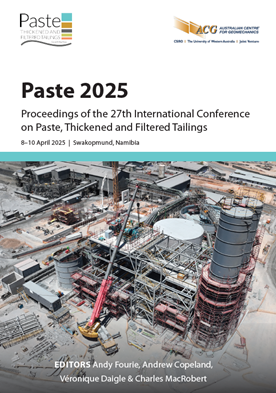ARTERRA™ ultra-high molecular weight polyethylene: a sustainable solution for slurry pipeline transportation

|
Authors: Hall, TD; Weerasekara, NS |
DOI https://doi.org/10.36487/ACG_repo/2555_17
Cite As:
Hall, TD & Weerasekara, NS 2025, 'ARTERRA™ ultra-high molecular weight polyethylene: a sustainable solution for slurry pipeline transportation', in AB Fourie, A Copeland, V Daigle & C MacRobert (eds), Paste 2025: Proceedings of the 27th International Conference on Paste, Thickened and Filtered Tailings, Australian Centre for Geomechanics, Perth, pp. 249-262, https://doi.org/10.36487/ACG_repo/2555_17
Abstract:
The efficient transportation of slurry through tailings pipelines in the mining sector is crucial for sustainable and environmentally responsible operations. The proportion of power drawn for tailings pipelines out of total pumping systems is significant due to pipeline length and losses. Pipeline losses can therefore become a large contributor to carbon emissions. This paper presents a theoretical comparative study on power draw arising from losses due to friction and weld beads along tailings pipelines in different pipeline materials, namely highdensity polyethylene (HDPE) and ARTERRA™ ultra-high molecular weight polyethylene (UHMWPE). The conventional HDPE connection process produces weld beads at joins which in turn increase turbulence around the bead and create losses. While previous research has often dismissed turbulence-induced losses as negligible, reports from onsite personnel across multiple sites suggest an increase in power draw compared to design expectations, which has been attributed to losses due to weld beads. In response, this study examines the losses using theoretical engineering calculations to quantify and evaluate the significance of these losses, supported by computational fluid dynamics (CFD) modelling. Unlike HDPE, ARTERRA UHMWPE connections are flanged and therefore, when connected, the pipeline will have no weld beads. In addition, ARTERRA exhibits a lower surface roughness coefficient, resulting in reduced friction losses. The reduced losses decrease the system head, which in turn can present environmental, social and governance (ESG) benefits due to reduced power consumption, depending on the power source. These benefits are quantified both as a financial saving and ESG carbon tonne reduction. This study aims to provide valuable insights for pipeline development in the mining sector with the goals of enhancing pipeline efficiency, reducing the energy footprint, reducing operational costs and improving pipeline sustainability. Between HDPE and ARTERRA long-distance tailings pipelines, this paper concludes that the observed power draw difference is 13–15%.
Keywords: tailings, pipelines, friction losses, sustainability, ESG, ARTERRA™, weld beads, UHMWPE, centrifugal pumping, computational fluid dynamics
References:
ASTM International 2010, Standard Practice for Heat Fusion Joining of Polyethylene Pipe and Fittings (ASTM F2620-06), ASTM International, West Conshohocken.
Idelchik, IE 2007, ‘Resistance to flow through orifices with sudden change in velocity and flow area resistance coefficients of sections with sudden expansion, sudden contraction, orifices, diaphragms, and apertures’, in Handbook of Hydraulic Resistance, 4th edn, Begell House, Inc, Redding, pp. 223–275.
International Organization for Standardization 2001, Plastics Pipes and Fittings — Butt Fusion Jointing Procedures for Polyethylene (PE) Piping Systems (ISO 21307), International Organization for Standardization, Geneva.
Piegorsch, WW 1989, ‘Durand’s rules for approximate integration’, Historia Mathematica, vol. 16, no. 3, pp. 123–130.
© Copyright 2025, Australian Centre for Geomechanics (ACG), The University of Western Australia. All rights reserved.
View copyright/legal information
Please direct any queries or error reports to repository-acg@uwa.edu.au
View copyright/legal information
Please direct any queries or error reports to repository-acg@uwa.edu.au
